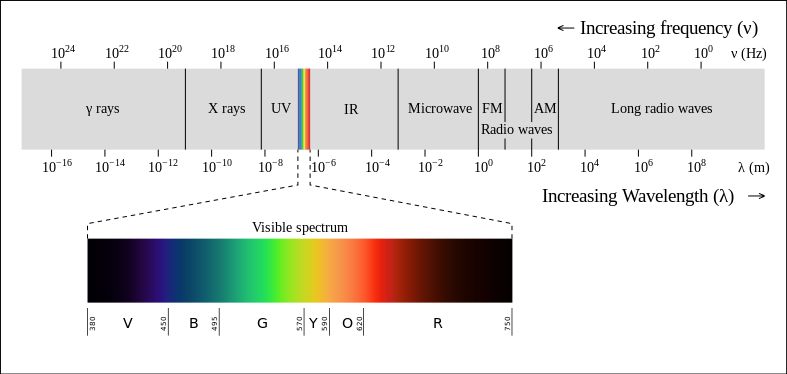
Caption: The electromagnetic spectrum.
Features:
- The continuum
of electromagnetic radiation (EMR)
is called the electromagnetic spectrum.
- We divide the
electromagnetic spectrum
into
wavelength bands
(or
frequency bands)
with SHARP BOUNDARIES
for convenience in analysis and often because these
wavelength bands
have different emission and absorption processes on average.
- There are, however, NO real SHARP BOUNDARIES in
electromagnetic spectrum---the
electromagnetic spectrum forms
a continuum as far as we can tell.
Some relatively sharp boundaries do occur in particular emission and absorption processes: e.g., absorption edges.
- The well-known
wave specification formulae
for EMR in
vacuum are, respectively,
fλ = c , λ=c/f , f = c/λ ,
where f is frequency, λ is wavelength, f is frequency and c is the vacuum light speed c = 2.99792458*10**8 m/s (exact by definition) ≅ 3*10**8 m/s = 3*10**5 km/s ≅ 1 ft/ns.
From the formulae, we see that frequency and wavelength are inversely related and contain the same information in different forms.
- Frequency bands:
gamma ray (old convention 0--0.1 Å),
X-ray (old convention 0.1 Å -- 0.01 μm),
ultraviolet = UV (0.01--0.4 μm)
(
extreme ultraviolet = EUV (0.01--0.121 μm),
far ultraviolet = FUV (0.121--0.2 μm),
middle ultraviolet = MUV (0.2--0.3 μm),
near ultraviolet = NUV (0.3--0.4 μm)),
visible (fiducial range 0.4--0.7 μm),
infrared (0.7 μm -- 0.1 cm),
microwave (0.1--100 cm),
radio (0.1 cm -- 10**5 km).
Image link: Wikipedia: File:EM spectrum.svg.
Local file: local link: electromagnetic_spectrum.html.
File: Electromagnetic Radiation file: electromagnetic_spectrum.html.